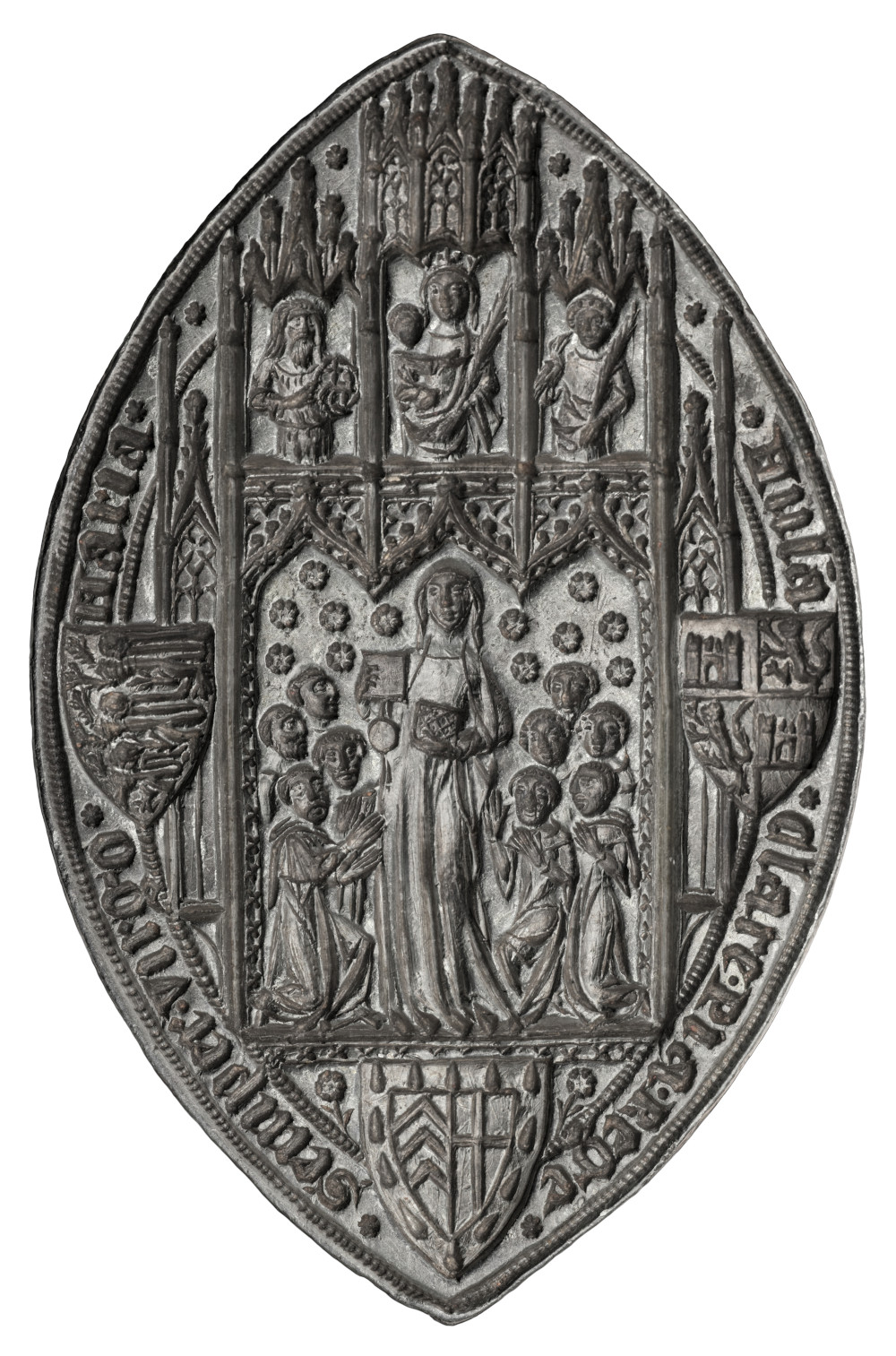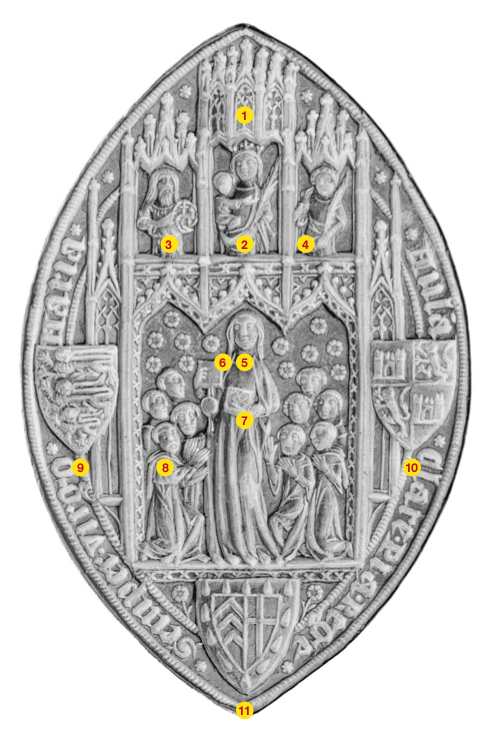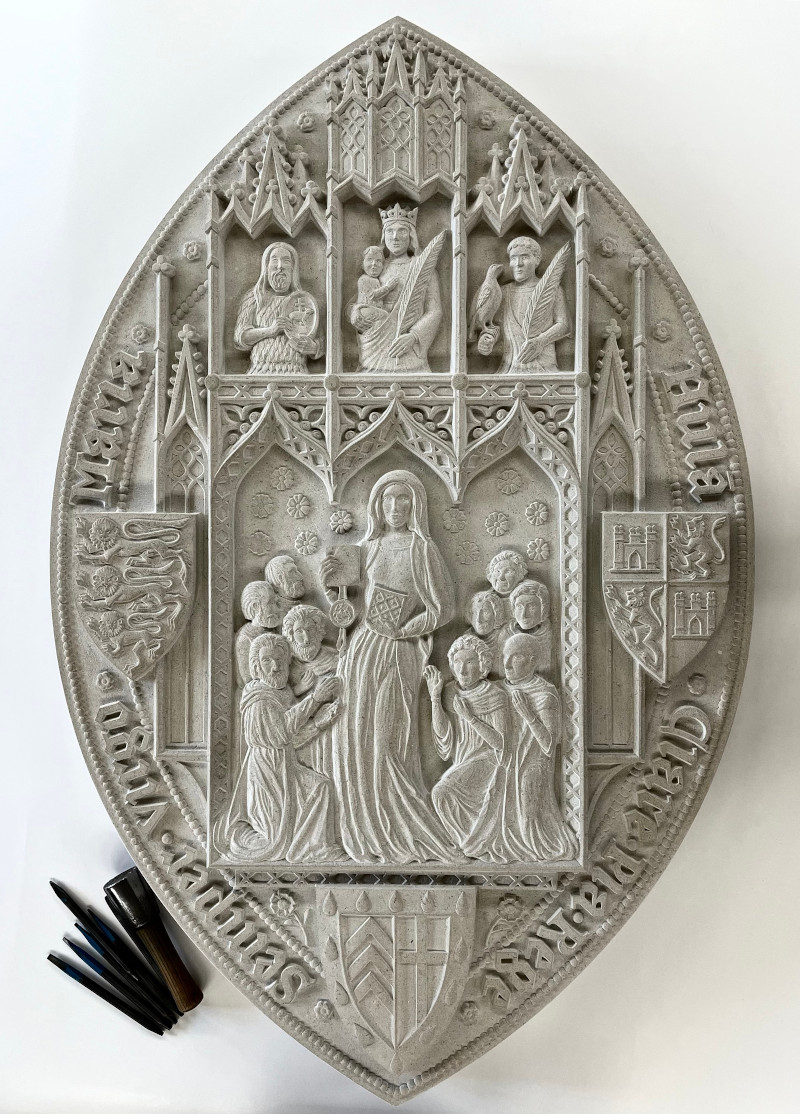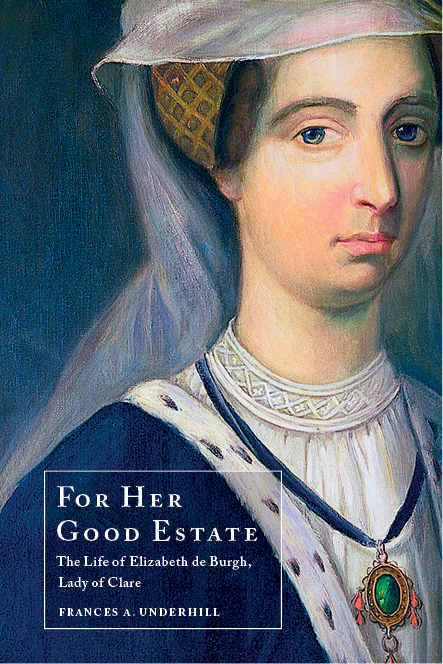



Authors: Claire Barnes, Lida Lopes Cardozo Kindersley & Jacqueline Tasioulas
Available
from Clare College
ISBN: 978-1-9163768-7-8
The seal of Clare College in the University of Cambridge dates back to 1359. It was used to ratify the statutes, and many other transactions over the centuries. Wax impressions were made by a silver matrix, a masterpiece of craftsmanship and a treasured physical link with the college’s patron, the Lady of Clare.
The seal identifies the College unmistakably, and expresses great hopes for the future. It depicts the statutes, which speak of the needs of a society battered by war and plague, and acts as their visual counterpart. The statutes and seal proclaim a determination to move forward with a vision of human talent, meritocracy, and the Precious Pearl of Learning.
Centuries later, this vision continues to inspire. A large stone sculpture of the seal was commissioned to celebrate the 50th anniversary of the admission of women, and the completion of major renovations to Old Court.
This booklet contains new photos and drawings of the medieval seal, and documents the commissioning and making of the new sculpture. It explores the iconography, and the evolution of the heraldry, in light of new evidence from archives and archaeology. It speaks of adversity and of hope.

When the statutes of Clare College were formalised, the text set out the four parties to the agreement, and their four wax seals were attached. On 26th March 1359, the statutes were sealed by Elizabeth de Burgh, Lady of Clare, at her home in Bardfield. The seal of Thomas de Lisle, Bishop of Ely confirmed his approval. In Cambridge the following day, the Master Nicholas Brunne and all the Fellows ratified the statutes using the new public seal of the College. So did the Chancellor, Thomas de Sutton, and an assembled congregation, applying the public seal of the University.
The seal of Clare College commemorates the occasion and was in regular use for several hundred years, a silver matrix used to make impressions upon wax. It shows Lady Elizabeth presenting the charter of foundation and the book of statutes to the kneeling Master and Fellows. Bearded senior figures and beardless younger men represent the whole community.
The inscription invokes for the College the eternal protection of the Virgin Mary:
and she is seen at the top, with a crown, holding the Child Jesus, flanked by St John the Baptist and St John the Evangelist.
The shields to left and right show the royal arms of England, and of Castile and León, asserting Elizabeth’s distinguished lineage. The lower shield depicts the final version of her personal arms, which were thereafter adopted by the College.
The statutes mention the seal, and the seal depicts the statutes. They were crafted together, with the seal as the visual counterpart to Elizabeth’s ringing introduction to the statutes, explaining her intentions to future generations.

- The canopy, pinnacles, tracery and ogee arches evoke contemporary architecture in wood and stone, still seen at Ely, and at Walsingham Friary which Elizabeth had founded twelve years earlier.
- The Virgin Mary, protector of the College. She is shown with a crown, and a palm signifying eternal life, holding the Child Jesus.
- St John the Baptist, identified by unkempt hair, beard, camel-hair garment, and carrying an oval wax Agnus Dei with image of lamb and cross. Clare College was in the parish of St John Zachary (the Baptist, son of Zachary).
- St John the Evangelist: young, beardless, with emblematic eagle poised to speak into his ear. John too carries a palm, evoking stories from the end of the Virgin’s life on earth. He was her closest supporter, associated with loyalty and duty as well as learning. St John’s Hospital, dedicated to the evangelist, was an important institution in Cambridge, which had been hard hit by plague.
- The Lady of Clare dominates the composition, with a strikingly confident stance, a fashionable Gothic sway, and a direct gaze which seems, like the statutes, to command ‘remembrance of our deed’.
- In her right hand, the charter of foundation, with its large pendent seal, the double-sided Great Seal of her cousin King Edward III.
- In her left hand, the book of statutes.
- The Master, Nicholas de Brunne, surrounded by the Fellows and Scholars. The statutes provide for both Fellows and Scholars, and the seal depicts bearded older men and beardless youths.
- Royal arms of England, three lions passant guardant: alluding to Elizabeth’s maternal grandfather, Edward I.
- Royal arms of Castile and León, quartering castles and lions rampant: alluding to Elizabeth’s maternal grandmother, Eleanor of Castile.
- Elizabeth’s final arms, adopted by the College: the chevrons of Clare, impaling the cross of Burgh (dynasties united by her first marriage), surrounded by a distinctive border with droplets.

The seal of Clare College is a powerful symbol of identity, like a brand image, designed to be seen and recognised. In modern times, documents with wax seals are rarely seen. Even at Clare College, many recent members have been unaware of the seal’s imagery. The beautifully crafted silver matrix is a physical link with the College’s fourteenth-century patron, who almost certainly would have taken a close interest in the design and handled it for approval, and with all the Masters and Fellows involved in formalities over the centuries. However, two-inch treasures are challenging to display. A much larger stone sculpture would make the design visible to members of the College on a daily basis.
To find out if this might be possible, the College turned to a local Cambridge firm. The Cardozo Kindersley Workshop had previously carved inscriptions for the College, and the soaring swifts tracing out a huge CC on the front of the accommodation block at St Regis. Would it be willing to attempt a seal sculpture? It accepted with enthusiasm - and found it had underestimated the challenges.
This project constrained us, not through any rigidity in the present but because we were in effect working to a brief created by a craftsman working in a different age, at a diferent scale, in a different medium. Moreover, he was working in mirror image to ensure that the impression would be legible, and in reverse depth, gouging into the surface to create the highest levels of the wax impression. By contrast, we had to carve away background waste, leaving elevated the features on which viewers will focus.
The sculpture has been completed, and the booklet presents The Stonecarvers' Tale.


FOR HER GOOD ESTATE: THE LIFE OF ELIZABETH DE BURGH, LADY OF CLARE
A second edition of the biography by Frances A. Underhill was published in 2020, with extensive additions and updates, as well as illustrations and navigation aids. Much of the added material is available for download on the booksite, https://barnes1.net/FHGE/; the resources page there also has a growing library of relevant links.
A print-on-demand paperback is available through bookshops and online sellers worldwide. The limited-edition hardback is slightly more expensive but better value; buy the FHGE hardback directly from Clare College and support Clare College Choir which receives 100% of the hardback sales proceeds.
Please also buy the seal booklet directly from Clare College: again the choir will receive 100% of the sale proceeds.
WHY A SEAL SCULPTURE? AND HOW?
Two talks and an unveiling on 1 July 2023, with Jacqueline Tasioulas on WHY a large stone sculpture was commissioned, Lida & Roxanne Kindersley on HOW.
Video, 35min in total: https://stories.clare.cam.ac.uk/unveiling-of-lady-clares-seal/
THE CARDOZO KINDERSLEY WORKSHOP
Makers of the Seal Sculpture: http://www.kindersleyworkshop.co.uk/
PUBLISHER
E-mail on the seal booklet's copyright page.
TWITTER (old posts)
https://twitter.com/@ClaireFromClare
#LadyofClare
![]()
MASTODON (current posts)
https://h-net.social/@ClaireFromClare
#LadyOfClare
![]()